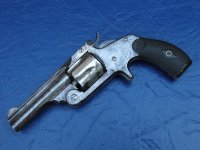I agree with glowe on this point. After making the statement that modern smokeless .38 S&W ammunition is unsafe or likely to cause damage, it is usually followed by some statement like "Smokeless powder produces a dangerously high pressure spike that black powder does not." If there is any evidence of truth to that statement as it applies to factory .38 S&W loads, I have never seen any. And I have looked hard. And in the many times that I have asked for anyone to provide authoritative proof of the existence of the "dangerous pressure spike" with smokeless powder, I have never received an answer. And I have never seen a warning on a factory box of .38 S&W smokeless ammunition that it is dangerous to use in the older revolvers of the black powder era.
This is hardly proof, but I do have an internal ballistics program called Quickload. I have no way of knowing what propellant or what charge the factories use, but jiggling the parameters to get an approximate MV of 650 ft/sec from a 146 grain lead bullet from 4" barrel graphically indicates there is no sharp pressure spike, but a shallow rise and fall, and that peak chamber pressure is a little over 8,000 psi with about any typical smokeless pistol powder one would care to use. And Quickload typically overestimates peak chamber pressure as compared to actual piezo gauge measurements. In any event, a peak pressure of 8,000 psi is low for any cartridge.

